Carl Zeiss Jena F. 101
| Das Fernrohr 101 (F. 101) ist ein terrestrishces Fernrohr zur Luftüberwachung oder Flugabwehr. Es könnte in ähnlicher Formn auch als Zielfernrohr an Flugzeugen selbst montiert worden sein (s. Foto u.). Es hat eine FL-Anforderungsnummer; diese ist 52283. Es ähnelt der Bauweise des "Aseros". Das vorliegende Stück hat einen schwarz lackierten Metalltubus (andere eine Hartgummiummantelung wie das Aseros), eine leicht angeschrägte Sonnenblende und ein Okular mit Dioptrienausgleich, allerdings fehlt im Gegensatz zu anderen Exemplaren eine Zoomeinstellung oder Justierung der Strichplatte (Fadenkreuz mit Kreis) zur Messung der Entfernung eines Flugzeuges. | The Telescope 101 (F. 101) is a terrestrial telescope for air surveillance or air defence. It may have been used as a aimning sight on aircrafts themselves (see photo). It has a Fl ordering number which is 52283. Its design resembles the "Aseros". The specimen here has a black lacquered metal tube (others come with an ebonite covering like the Aseros), a slightlyslanting sunshade, and a n eyepiece with a dioptre adjustment. Yet, contrary to other models, this one does not have any zooming facilities or adjustment of the reticle (cross-hairs with a circle) to estimate the distance of an airplane. |
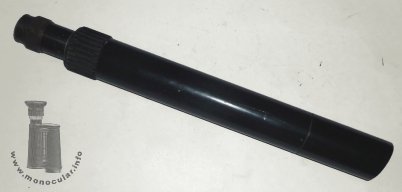
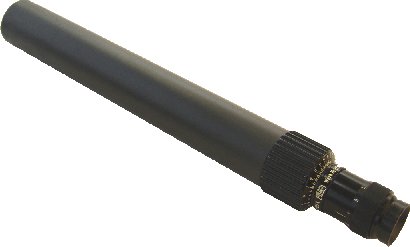
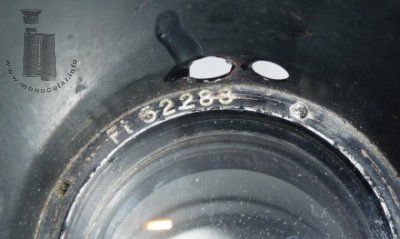

| Für diesen Zweck gibt es auf der Augen-gerichteten Seite des Tubus zwei Skalen zur Abgleichung der bekannten Flügel-Spannweite (in m) und Entfernung (in hm). Dies hier wäre dann ggf. ein einfaches Zielfernohr. die anderen Modelle haben einen drehbaren Ring (für die Spannweite) der meistens mit dem Firmennamen "Carl Zeiss Jena" im Logo sowie dem Modellnamen "F. 101" (ggf. 101a) sowie der Werknummer 221037 beschriftet ist (s.a. Beobachtungsgeräte bei www.deutscheluftwaffe.de). | For this purpose, there are two scales a the eyepiece end of the main tube. They allow to read the distance in metres ("Entfernung"; hm = height metres) when the wing-span ("Spannweite") of an airplane (in metres) is known. The model here would be a simple aiming sight; the other spoecimen have a turnable ring (adjsuting the wing-span) which is marked with the Carl Zeiss logo and name, the model nam "F. 101" (or 101A), and a number referrring to the branch (works number), i.e. "221037" (cf. also Beobachtungsgeräte bei www.deutscheluftwaffe.de.). |
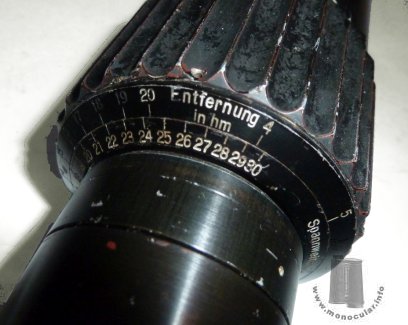
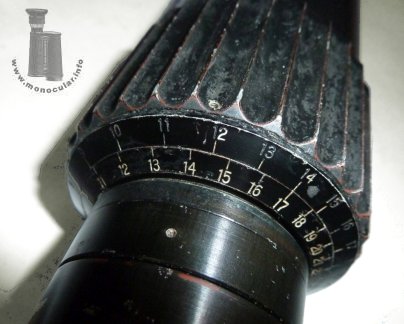
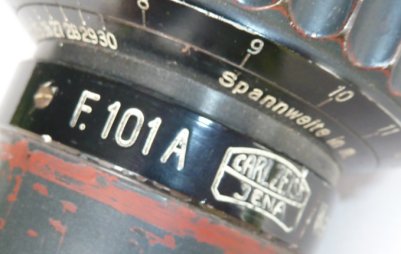
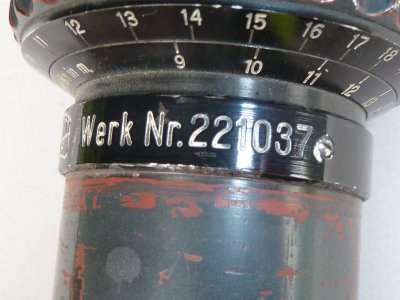
| Das Fernrohr konnte auf einem Stativ mit Klemmschelle befestigt werden. Es hat ein 47mm Objekitv und eine innenliegende Umkehrlinse, die an einem Tubus an dem Objektivendtubus angeschraubt ist (s. Foto mit Teilen). Die Bergrößerung ist bei 12x fixiert. | The telesocpe could be mounted on a tripod with a clamp. It has a 47mm objective and an inner erecting lens, which is attached to a tube, the latter again being screwed onto the obejctive tube inside. (see picture showing parts). The magnification is fixed to 12x.. |
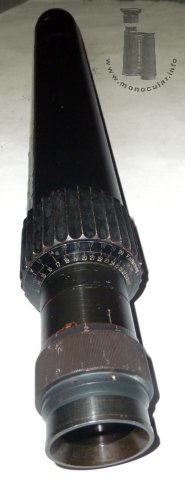
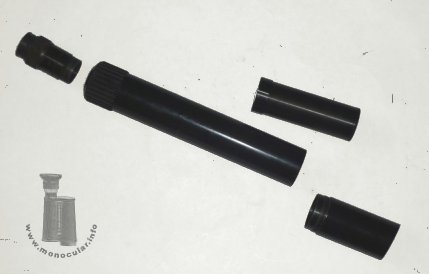
| Das F.101 ist ca. 25-26cm lang, hat einen Tubusdurchmesser von 63mm, beim Okularstück von 45mm und am Fokussierungsring von 52mm. Es wiegt ca. 1500g. Im Buch von H. Seeger "Zeiss - Handferngläser 1919-1946" (2015) wird auf S. 234 ein weiteres "Luftwaffen-Aseros" gezeigt. |
The F.101 is about 25-26cm long. The main tube is 63mm, the eyepiece 45mm, and the focusing part 52mm in diameter. It weigs c. 1500g. In H. Seeger's book "Zeiss - Handferngläser 1919-1946" (2015) another "Luftwaffen-Aseros" is pictured on page 234. |
Fotos: Zeun; Internet

